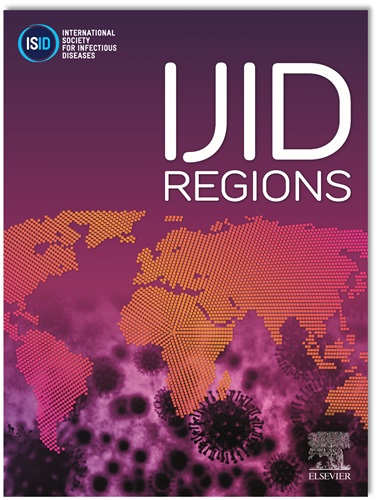2012-2024年西班牙Q热病例中伯纳蒂克希菌基因型的高度多样性
IF 4.3
2区 医学
Q1 INFECTIOUS DISEASES
引用次数: 0
摘要
本研究的目的是揭示在西班牙人类临床病例中发现的伯纳蒂胞杆菌的遗传多样性,以增加对基础和分子流行病学的认识。Q热是一种全球性的人畜共患疾病,由伯纳蒂克希菌引起。伯纳蒂克希菌是一种细胞内革兰氏阴性细菌,对不利环境条件表现出显著的适应能力。自2017年以来,西班牙每年通报的人类病例数量最多,然而,关于人类感染中流行基因型的信息有限。方法:回顾性分析2012-2024年在西班牙诊断为Q热的患者样本。采用单核苷酸多态性(SNP)分析伯纳氏Coxiella burnetii基因型。结果:在最初分析的66个样本中,有52个样本正确识别出6种不同的基因型(SNP1-SNP3、SNP6、SNP8和SNP9),从而揭示了人类临床样本的高遗传变异性。结论:西班牙伯纳蒂克希菌在人类临床样本中表现出较高的遗传变异性,揭示了分子变异性与临床症状之间可能存在的地理分布规律,因此需要进一步对家畜、野生动物和蜱等其他宿主物种进行研究,以明确该细菌的分子流行病学。本文章由计算机程序翻译,如有差异,请以英文原文为准。
High diversity of Coxiella burnetii genotypes in Q fever human cases from Spain, 2012-2024
Objectives
The aim of this study is to reveal the genetic diversity of Coxiella burnetii found in human clinical cases in Spain to increase knowledge of its basic and molecular epidemiology. Q fever is a globally zoonotic disease caused by C. burnetii, an intracellular gram-negative bacterium that demonstrates remarkable resilience to adverse environmental conditions. Spain has had the highest number of annually notified human cases since 2017; however, information on circulating genotypes in human infections is limited.
Methods
We retrospectively analyzed samples from patients diagnosed with Q fever in Spain during 2012–2024. Coxiella burnetii genotypes were determined by single nucleotide polymorphism (SNP) analysis.
Results
Six different genotypes (SNP1–SNP3, SNP6, SNP8, and SNP9) were correctly identified in 52 out of 66 initially analyzed samples, revealing high genetic variability in human clinical samples.
Conclusions
Coxiella burnetii in Spain showed a high genetic variability in human clinical samples, revealing a possible geographical pattern between molecular variability and clinical signs, thus we can conclude that further research in other reservoir species such as livestock, wildlife and ticks is needed to clarify the molecular epidemiology of the bacterium.
求助全文
通过发布文献求助,成功后即可免费获取论文全文。
去求助
来源期刊
CiteScore
18.90
自引率
2.40%
发文量
1020
审稿时长
30 days
期刊介绍:
International Journal of Infectious Diseases (IJID)
Publisher: International Society for Infectious Diseases
Publication Frequency: Monthly
Type: Peer-reviewed, Open Access
Scope:
Publishes original clinical and laboratory-based research.
Reports clinical trials, reviews, and some case reports.
Focuses on epidemiology, clinical diagnosis, treatment, and control of infectious diseases.
Emphasizes diseases common in under-resourced countries.

 求助内容:
求助内容: 应助结果提醒方式:
应助结果提醒方式:


